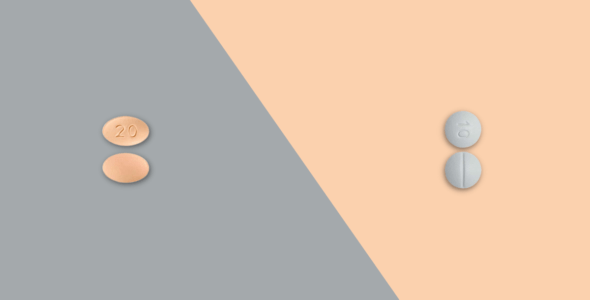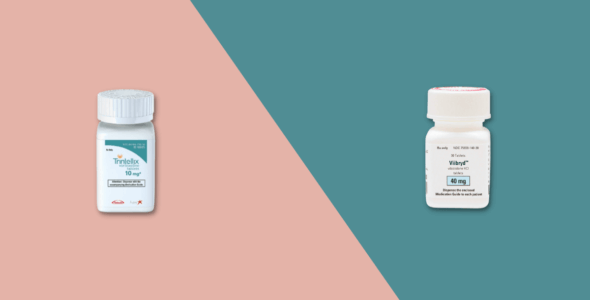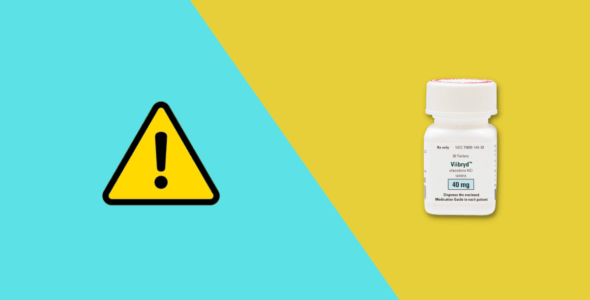Viibryd Dosage, forms & strengths
Complete a free online enrollment application to find out if you’re eligible to pay only $49 per month for your Viibryd medication.
Get started todayViibryd (vilazodone hydrochloride) is a prescription antidepressant medication that is manufactured by Allergan USA, Inc. It is approved by the U.S. Food and Drug Administration (FDA) for the treatment of major depressive disorder (MDD) in adults aged 18 years and older.
Viibryd is considered a selective serotonin reuptake inhibitor (SSRI)/partial 5-HT1A receptor antagonist. It does not significantly affect the levels of dopamine or norepinephrine. Viibryd’s antidepressant effect is believed to be because it inhibits serotonin reabsorption to increase serotonin concentrations. Researchers are not sure if its partial agonist activity at serotonergic 5-HT1A receptors contributes to Viibryd’s therapeutic effect.
Viibryd showed its effectiveness and safety in adults with MDD in 2 randomized, double-blind, placebo-controlled clinical trials that lasted 8 weeks. Patients taking Viibryd had bigger improvements in depressive symptoms when compared to placebo.
Viibryd dosage forms and strengths
Viibryd is available as an oral tablet in the following strengths:
- 10 mg tablet
- 20 mg tablet
- 40 mg tablet
Viibryd dosage
Your dosage of Viibryd should be titrated up, starting with 10mg once a day for 7 days, followed by 20mg once a day. Your dose can then be increased to a maximum of 40mg once a day as long as 7 days have passed between dosage increases. When stopping Viibryd, you should reduce the dose gradually to avoid withdrawal symptoms and other adverse effects.
Viibryd adult dosage chart
| Indication | Starting dosage | Standard dosage | Maximum dosage |
|---|---|---|---|
| Major depressive disorder (MDD) | 10mg by mouth once daily with food for 7 days. | 20mg to 40mg by mouth once daily with food. | 40mg per day. |
The safety and efficacy of Viibryd have not been established in pediatric patients aged 18 years and younger.
Viibryd dosage restrictions
- The Viibryd dose should not exceed 20mg once a day if it is taken along with a strong CYP3A4 inhibitor such as Biaxin (clarithromycin) or Nizoral (ketoconazole). The original dose of Viibryd can be restarted after the inhibitor is stopped.
- Patients taking strong CYP3A4 inducers such as Tegretol (carbamazepine), Dilantin (phenytoin), and Rifadin (rifampin) for more than 2 weeks may have their dose increased. It is gradually increased over 1 to 2 weeks to a maximum of 80mg once a day. The Viibryd dose can be slowly reduced back to its original level over 1 to 2 weeks when the inducer is stopped.
- No dose adjustment is needed in patients with kidney (renal) or liver (hepatic) impairment.
How to take Viibryd
- Read the Full Prescribing Information including the Black Box Warning and Medication Guide that comes with Viibryd.
- Viibryd should only be taken exactly as prescribed by your healthcare provider. Do not stop taking or change your dose of Viibryd without discussing it with them first.
- Viibryd is taken once daily with food.
- If you miss a dose of Viibryd, take it right away. If it’s almost time for your next dose, skip the missed dose and take it at your regular time. Do not take extra doses of Viibryd to make up for the missed dose.
- If you think you have taken too much Viibryd, call your doctor or poison control center at 1-800-222-1222 for medical advice as soon as possible, or get emergency treatment immediately.
- Store Viibryd at room temperature between 68°F to 77°F (20°C to 25°C).
Viibryd dosage FAQs
What are some common side effects of Viibryd?
Some common possible side effects (incidence ≥1%) of Viibryd include:
- Nausea
- Vomiting
- Diarrhea
- Trouble sleeping
- Abnormal dreams
- Dizziness
- Dry mouth
Viibryd can rarely cause some serious side effects including:
- Increased risk of serotonin syndrome, which can be life-threatening (tremors, high blood pressure, confusion, muscle rigidity, and seizures)
- Increased risk of suicidal thoughts and behaviors, particularly in young adults under the age of 25
- Increased risk of bleeding
- Discontinuation symptoms if you suddenly stop taking Viibryd
- Angle-closure glaucoma (eye pain, changes in vision)
- Symptoms of mania or hypomania such as increased energy, racing thoughts, reckless behavior, and extreme happiness or sadness
- Hyponatremia (low sodium levels)
- Sexual dysfunction
- Erectile dysfunction
- Allergic reactions
Contact your doctor about any side effects or worsening symptoms you experience while taking Viibryd. You can report your side effects to the FDA at 1-800-FDA-1088 or www.fda.gov/medwatch.
What are some drug interactions with Viibryd?
When Viibryd is taken with other medications, they may interact and change how they work. Make sure your healthcare professional is aware of all the prescription and over-the-counter medications, vitamins, and herbal supplements you take, including:
- SSRIs such as Zoloft (sertraline) and Prozac (fluoxetine)
- Serotonin-norepinephrine reuptake inhibitors (SNRIs) such as Pristiq (desvenlafaxine)
- Tricyclic antidepressants (TCAs) such as Elavil (amitriptyline)
- Monoamine oxidase inhibitors (MAOIs) such as Nardil (phenelzine)
- Triptans such as Zomig (zolmitriptan)
- Anticoagulants such as Coumadin (warfarin) and aspirin
- Nonsteroidal anti-inflammatory drugs (NSAIDs) such as Motrin (ibuprofen) and Aleve (naproxen)
- Diuretics
- Ultram (tramadol)
- Buspar (buspirone)
- Lithobid (lithium)
- St. John’s Wort
- Tryptophan
- Amphetamines
Are there any contraindications or precautions with Viibryd?
You should not take this medication if you have had an allergic reaction to Viibryd or any of its inactive ingredients.
You should not take MAOIs intended to treat psychiatric disorders within 14 days of your last dose of Viibryd. In addition, you should not take Viibryd along with linezolid or intravenous (IV) methylene blue.
Before starting Viibryd, make sure your healthcare provider is aware of all your medical conditions, including:
- Personal or family history of mania, hypomania, or bipolar disorder
- Seizure disorder
- Glaucoma
- Bleeding disorders
- Hyponatremia (low sodium levels in your blood)
- Are pregnant, plan on becoming pregnant, or are breastfeeding
How long does Viibryd stay in your system?
With an elimination half-life of approximately 25 hours, Viibryd will stay in your bloodstream for a little more than 5 days after the last dose.
Is it safe to use Viibryd while pregnant or breastfeeding?
There are not any well-controlled clinical studies on the use of Viibryd in pregnant women. Taking Viibryd during the 3rd trimester may increase the risk of persistent pulmonary hypertension and discontinuation symptoms after the baby is born. There is a registry for patients who take Viibryd during pregnancy to track health information. You can register with the National Pregnancy Registry for Antidepressants online or at 1-844-405-6185.
It is unknown if Viibryd passes into breast milk or the effects it may have on the infant during lactation. You should always discuss the risks and benefits of any medication with your healthcare provider if you are pregnant, plan on becoming pregnant, or are breastfeeding.
Will lab monitoring be done when taking Viibryd?
- You should be monitored for the symptoms of serotonin syndrome if you take Viibryd with other serotonergic drugs.
- Your international normalized ratio (INR) should be closely monitored when starting, titrating, or stopping Viibryd while on Coumadin (warfarin).
- Family members or caregivers of patients taking Viibryd should closely monitor them for new or worsening suicidal thoughts as well as unusual changes to their mood and behavior.
Related resources for Viibryd dosage
- https://www.rxabbvie.com/pdf/viibryd_pi.pdf
- https://www.abbvieaccess.com/brand/viibryd
- https://www.ncbi.nlm.nih.gov/pmc/articles/PMC3278186/
- https://reference.medscape.com/drug/viibryd-vilazodone-999620#6
- https://www.pdr.net/drug-summary/Viibryd-vilazodone-hydrochloride-2452#15



